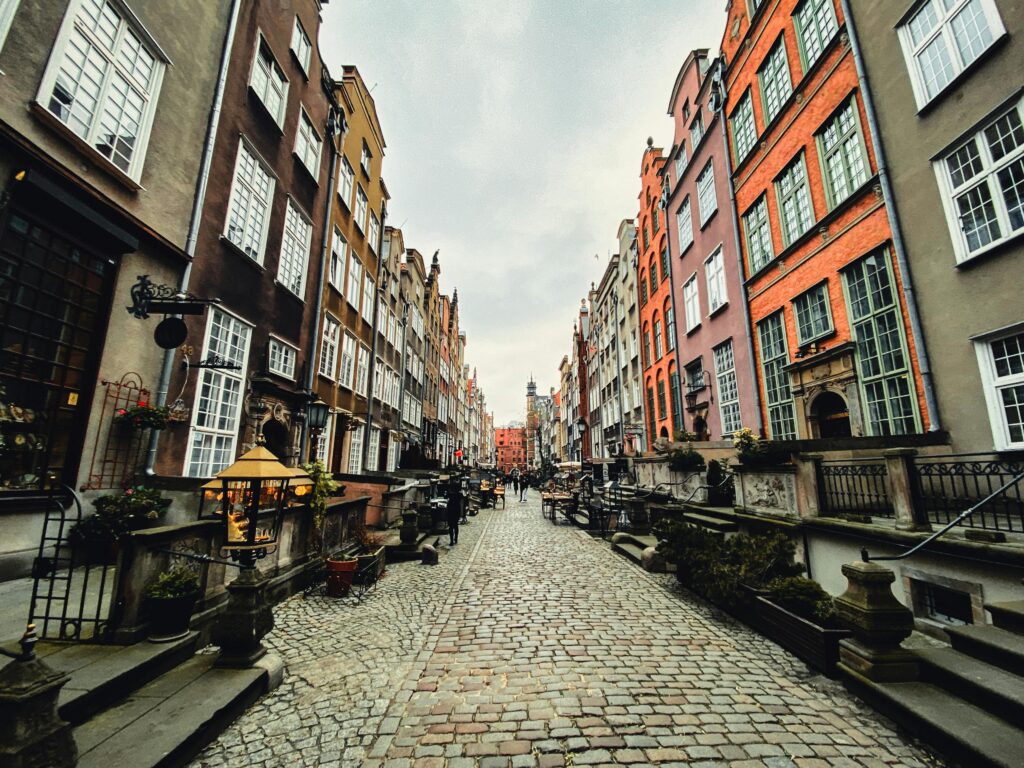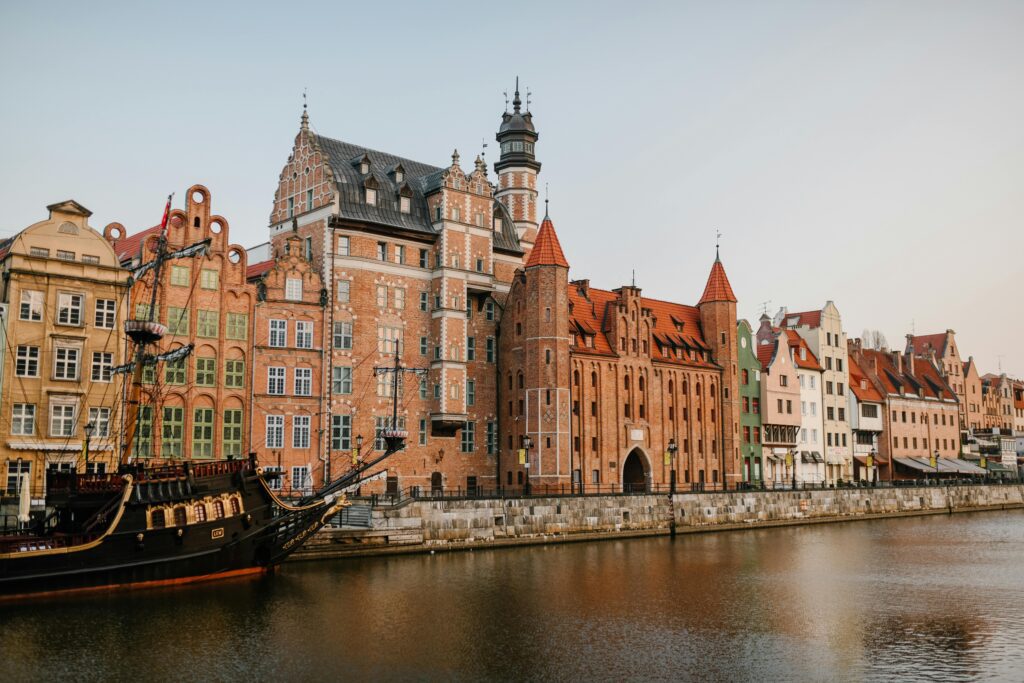“Discover essential tips for a memorable trip to Gdansk, Poland. Uncover hidden gems, local cuisine, and must-see sights.”
Introduction to Gdansk
Gdansk, Poland, is a coastal gem where history whispers through cobblestone streets and amber glows in shop windows. As a UNESCO World Heritage Site, its Old Town blends Gothic spires, Hanseatic merchant houses, and a resilient spirit shaped by WWII and the Solidarity movement.

Why Visit Gdansk?
– Rich History: From the iconic Neptune’s Fountain to the European Solidarity Centre, Gdansk is a living museum of European history.
– Affordable Charm: Meals from 30 PLN ($7.50), hostels from 80 PLN ($20/night), and free walking tours make it budget-friendly.
– Baltic Beauty: Motława River sunsets and sandy beaches in nearby Sopot offer a perfect coastal escape.
– Cultural Hub: Vibrant arts scene, from amber workshops to jazz clubs in the old shipyards.
Personal Anecdote: Over steaming pierogi at Bar Pod Rybą, a local artist taught me how amber—Gdansk’s “gold”—captures sunlight like the city itself: warm, golden, and timeless. He handed me a raw piece, still rough from the Baltic shores, and said, “Hold it to the light—see how it holds fire?” That moment encapsulated Gdansk’s magic: a blend of natural beauty and human craftsmanship.
Map of Gdansk
Planning Your Trip
Best Time to Visit Gdansk
- Peak Season (June–August): Warm (75°F/24°C), lively festivals like St. Dominic’s Fair (Europe’s oldest street market), but crowded. Book accommodations 3+ months ahead.
- Shoulder Seasons (May, September): Mild weather (60–68°F/15–20°C), fewer tourists, and lower prices. Perfect for photography and leisurely exploration.
- Winter (December–February): Snow-dusted charm and Christmas markets (try grzaniec, mulled wine), but chilly (23°F/-5°C). Ice skating on the Motława River is a highlight.
Essential Packing List
- Footwear: Sturdy shoes for cobblestones—think cushioned soles for Long Market’s uneven stones.
- Layers: Baltic winds shift quickly—pack a waterproof jacket and a warm sweater even in summer.
- Tech: Type E power adapter + portable charger (outlets are rare in historic cafés).
- Extras: A reusable water bottle (tap water is safe) and a small umbrella.
Pro Tip: Gdansk’s weather can change hourly. Check Meteo Gdansk before heading out.
Note: Book early for summer deals!
3-Day Gdansk Itinerary

Day 1: Old Town Highlights
Morning:
– Start at Long Market (Długi Targ), the heart of Gdansk. Admire the Golden Gate, a 17th-century masterpiece, and Neptune’s Fountain, where locals toss coins for luck.
– Climb St. Mary’s Basilica (462 steps!) for panoramic views. The climb is steep, but the sight of red rooftops against the Baltic Sea is unforgettable.
Afternoon:
– Lunch at Pierogarnia Mandu (ul. Długa 46). Try the duck pierogi with cranberry sauce or the ruskie (potato-cheese) dumplings. Portions are generous—split a plate if you’re light on appetite.
– Explore the Museum of Amber (ul. Targ Węglowy 26), where you’ll see prehistoric insects trapped in golden resin. Don’t miss the reconstructed amber workshop.
– Alternatively, visit Artus Court, a former merchant meeting hall with a stunning 36-foot-tall tiled stove.
Evening:
– Sunset cruise on the Motława River (50 PLN, 1 hour). Glide past the Crane (Żuraw), a medieval port crane, and watch the city lights flicker on.
– Dinner at Restauracja Kubicki (ul. Wartka 5), a 16th-century cellar serving flaki (tripe soup) and bigos (hunter’s stew).
Day 2: History & Coastal Escape
Morning:
– Visit the European Solidarity Centre (Pl. Solidarności 1, 25 PLN). This interactive museum chronicles Poland’s fight against communism. The rust-colored walls, made from shipyard steel, echo Gdansk’s industrial past.
Afternoon:
– Take the SKM train to Sopot (20 mins, 8 PLN). Stroll the Monte Cassino Street, lined with art nouveau villas, then walk the pier (longest wooden pier in Europe) for Baltic Sea views.
– Lunch at Brovarnia Sopot (Pl. Konstytucji 3 Maja 3), a microbrewery with smoked herring platters and honey-infused ale.
Evening:
– Return to Gdansk for dinner at Restauracja Gdańska (ul. Długa 23). Order the smoked herring with apple-onion salad—a local specialty.
Day 3: Day Trips & Hidden Gems
Morning:
– Train to Malbork Castle (1 hour, 25 PLN). This UNESCO-listed fortress is Europe’s largest brick castle. Join a guided tour to hear tales of Teutonic Knights and secret tunnels.
Afternoon:
– Explore Oliwa Cathedral (ul. Biskupa Edmunda Nowickiego 5). Attend the 12:00 PM organ concert—the 18th-century instrument has 7,876 pipes!
– Wander the Oliwa Park, a tranquil green space with peacocks and a Japanese garden.

Evening:
– Craft beers at Brovarnia Gdańsk (ul. Szafarnia 9). Try the Baltic Porter, a dark, malty brew.
Gdansk Travel Tips
Budget Tips
- Eat Cheap: Milk bars (e.g., Bar Mleczny Neptun) serve placki ziemniaczane (potato pancakes) for under 15 PLN.
- Free Sights: Walk the Royal Way or visit St. Bridget’s Church, home to an amber altarpiece.
- City Card: The Gdansk Tourist Card (75 PLN/3 days) covers public transport and museum discounts.
Local Transportation
- Trams/Buses: Single ride 3.20 PLN; 24-hour pass 13 PLN. Validate tickets onboard—fines are 150 PLN!
- Biking: Rent a bike (25 PLN/day) to explore the Motława River Path.
Personal Anecdote: I skipped a tram to follow the scent of fresh obwarzanek (Polish pretzels) from a street vendor. The warm, sesame-coated dough cost 3 PLN—worth every step!
Safety & Etiquette
- Emergency Number: 112.
- Cultural Notes:
- Greet with “Dzień dobry” (Good day) and say “Dziękuję” (Thank you).
- Tipping 10% is customary—leave cash, as card machines often skip tip options.
- Remove shoes when entering Polish homes.
FAQs About Gdansk
1. Is Gdansk safe for solo travelers?
Yes! Violent crime is rare. Stick to well-lit areas at night (e.g., Old Town) and watch for pickpockets in crowds during festivals.
2. What’s the best way to get from the airport to the city center?
Take bus #210 (4.60 PLN, 30 mins) or a taxi (~80 PLN). Avoid unlicensed cabs—use Neptun Taxi (+48 58 9627).
3. Can I use euros in Gdansk?
No—Polish złoty (PLN) is standard. ATMs (e.g., PKO Bank) offer better rates than exchange offices.
4. What’s a must-try local dish?
– Pierogi ruskie (potato-cheese dumplings).
– Flaki (tripe soup—brave it with a shot of żubrówka vodka).
– Oscypek (smoked sheep cheese from the Tatra Mountains).
5. Is English widely spoken?
Yes, especially in tourist areas, but Poles appreciate basic Polish phrases. Learn:
– “Na zdrowie!” (Cheers!)
– “Gdzie jest toaleta?” (Where’s the toilet?)
Conclusion: Start Your Gdansk Adventure!
Gdansk is a city of contrasts—medieval grandeur meets maritime energy, and every alley hides a story. Whether you’re tracing history at Westerplatte or savoring a quiet moment by the river, this guide ensures you’ll experience the best of Poland’s Baltic jewel.
Note: Ready to explore? Book your trip today—Gdansk’s charm won’t wait!
Keywords:
1. “Gdansk Poland travel guide” 2. “Best time to visit Gdansk for sightseeing” 3. “What to do in Gdansk Old Town” 4. “Top attractions in Gdansk Poland” 5. “How to spend a weekend in Gdansk Poland?”



